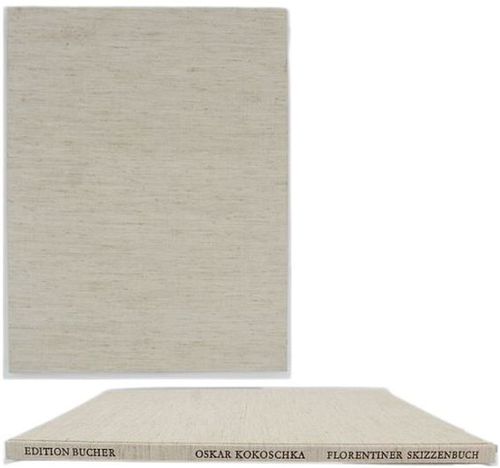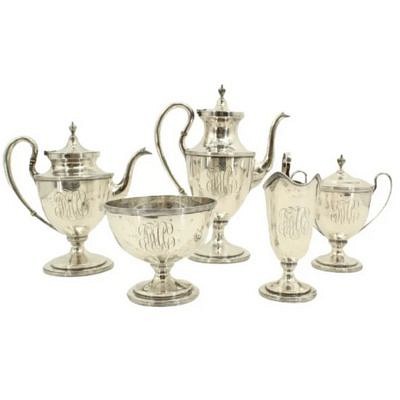Oskar Kokoschka, Florentiner Skizzenbuch 1972
About Seller
522 South Pineapple Avenue
Sarasota, FL 34236
United States
Sarasota Estate Auction specializes in a wide variety of furniture, antiques, fine art, lighting, sculptures, and collectibles. Andrew Ford, owner and operator of the company, has a passion for finding the best pieces of art and antiques and sharing those finds with the Gulf Coast of Florida.
Two ways to bid:
- Leave a max absentee bid and the platform will bid on your behalf up to your maximum bid during the live auction.
- Bid live during the auction and your bids will be submitted real-time to the auctioneer.
Bid Increments
| Price | Bid Increment |
|---|---|
| $0 | $10 |
| $100 | $25 |
| $250 | $50 |
| $1,000 | $100 |
| $2,500 | $250 |
| $7,500 | $500 |
| $20,000 | $1,000 |
| $50,000 | $2,500 |
| $100,000 | $5,000 |
| $250,000 | $10,000 |
About Auction
Jan 20, 2024
Artists to include: Jorge Blanco, Leonardo Nierman, Picasso, LeRoy Neiman, Darrell Crisp, Francois Krige, Mino Delle Site, Peter Max, Edward Povey, Sky Jones, Robert Rauschenberg, and others. There are also 7 Original Charles Schulz Drawings done by Reuben Timmins, Production Cels, over 200 lots of Important Books and Manuscripts, Sterling Silver, a Jane Kostick Geometric Wooden Sculpture, Modern Design and Furniture, Fantastic Estate Jewelry, and so much more! Sarasota Estate Auction sarasotaestateauction@gmail.com
- Lot Description
Oskar Kokoschka, Florentiner Skizzenbuch 1972. The title page of this books reads “Oskar Kokoschka, Florentiner Skizzenbuch, Vierundzwanzig Taseln in der GroBe der Originale Herausgegeben von Georg Theodor Ganslmayr Mit einer Einführung von Heinz Spielmann, Edition Bucher Luzern”, which translates to “Oskar Kokoschka, Florentine Sketchbook, With Twenty-four Plates in the Size of the Original, Edited by Georg Theodor Ganslmayr, With an introduction by Heinz Spielmann, Edition Bucher Lucerne”. The spine reads “Edition Bucher, Oskar Kokoschka, Florentiner Skizzenbuch”, on beige linen boards, with the initials of Oskar Kokoschka in a brown-ruled square on the front cover, blank endpapers, a half title, then the title page, two colored lithographs that are signed by Kokoschka and laid in before the three-page introduction by Heinz Spielmann - the two lithographs are hand-colored and signed “XX of 175” in pencil, with Kokoschka’s signature in the lower right of both lithographs - then the 24 plates, one page about the history of each plate - Zu Den Tafeln - and one page of Itinerar Der Reisen, Aug Denen Zie Zeichnungen Enstanden - an Itinerary of the journeys on which the drawings were made; the book comes in a beige linen slipcase, and it is a limited and numbered first edition that was published in Lucerne in 1972. The copyright page reads “Oskar Kokoschka, Florentiner Skizzenbuch, erscheint in deutscher und englische Sprache in folgenden Ausführungen und Auflagen: Normalausgabe, je 300 Exemplare, numeriert von I bis 300; Vorzugsausgabe, je 100 Exemplare, numeriert vom LXXVI bis CLXXV, mit einer numerierten, signierten und auf Bütten gedruckten Hand-Lithographiegedruckten Original-Lithographie (nach Raffael, Papst Leo X.); Vorzugssonderausgabe, je 75 Exemplare, numeriert von I bis LXXV, mit der Original-Lithographie der Vorzugssonderausgabe und einer farbigen, signierten und numerierten, auf Bütten gedruckten Hand-Lithographie gedruckten Hand-Lithographie (nach Bartolommeo Ammanati, FluBgott vom Neptun-Brunnen, Florenz), Dieses Exemplar tragt die Nummer XX, @ 1972 … “, which translates to “Oskar Kokoschka, Florentine Sketchbook, is published in German and English in the following versions and editions: standard edition, 300 copies each, numbered from I to 300; Special edition, 100 copies each, numbered from LXXVI to CLXXV, with a numbered, signed and original lithograph printed on laid paper (after Raphael, Pope Leo X); Special deluxe edition, 75 copies each, numbered from I to LXXV, with the original lithograph of the special deluxe edition and a colored, signed and numbered lithograph printed on laid paper (after Bartolommeo Ammanati, FluBgott vom Neptune-Fountain, Florence)”. Oskar Kokoschka (1886 - 1980) was an Austrian expressionist writer and painter. Born in Pöchlarn, he began his training at the age of 18 when he was awarded a scholarship to attend the Kunstgewerbeschule (now the University of Applied Arts) in Vienna, where he studied lithography and drawing under the tutelage of artists such as Gustav Klimt. Nevertheless, his financial situation was precarious and forced him to spend most of his time on decorative work, but in 1908 he met Adolf Loos, an eminent Viennese architect who was impressed by Kokoschka’s early paintings and became his main mentor, and this enabled the 22-year-old to find his way in the art world. His work had a resolutely expressionist style, where he aspired to capture the personality and character of his subjects, rather than their physical appearance. Kokoschka studied there from 1904 to 1909 and had no formal training in painting, so he approached the medium without regard to the "traditional" or "correct" way to paint. His first commissions were postcards and drawings for children, and his early career was marked by portraits of Viennese celebrities, painted in a nervously animated style. The 17th-century Czech humanist and education reformer, Jan Amos Comenius, was a primary influence on how to approach education. From Comenius’s theories, Kokoschka adopted the belief that students benefit most from using their five senses to facilitate reasoning, and he taught through storytelling filled with mythological themes and dramatic emotion - works that drew upon the subconscious rather than optical vision. This concept, in accord with Kandinsky’s theory about spirituality in art, became the basis for what art historians understand as Viennese Expressionism. Kokoschka was appointed Commander of the Order of the British Empire in the 1959 New Year Honours; he also received the Erasmus Prize in 1960 together with Marc Chagall. He was naturalized as a British subject in 1947 and would only regain Austrian citizenship in 1978; he travelled briefly to the United States in 1947 before settling in Villeneuve, Switzerland in 1953, where he lived for the rest of his life. Kokoschka had much in common with his contemporary, Max Beckmann. Both maintained their independence from German Expressionism, yet are now regarded as textbook examples of the style. Nonetheless, their individualism set both apart from the movements of twentieth-century modernism. Both wrote eloquently of the need to develop the art of "seeing" - Kokoschka emphasized depth perception, while Beckmann was concerned with mystical insight into the invisible realm - and both were masters of innovative oil-painting techniques anchored in traditions of the past. Kokoschka died in Montreux, Switzerland, in 1980, and his work has been offered at auction multiple times, with prices realized from $1 to $20,395,200 (USD), depending on the size and medium of the work, and the book and lithographs here are exquisite. The book is a large 4to. and measures 18 3/4 x 14 3/8 in. wide, in a tight binding with clean text and clean lithographs, a combination that is hard to beat, and the slipcase is exquisite as well. #5447
- Shipping Info
-
SHIPPING INFORMATION·
Sarasota Estate Auction IS NOT RESPONSIBLE FOR SHIPPING. All shipping will be handled by the winning bidder. Sarasota Estate Auction recommends obtaining shipping quotes before bidding on any items in our auctions. If you are interested in obtaining any information on local shippers, please send us an email and we will kindly send you a list of local shippers. Refunds are not offered under any circumstances base on shipping issues, this is up to the buyer to arrange this beforehand.
Premier Shipping, info@premiershipment.com
BIDDER MUST ARRANGE THEIR OWN SHIPPING. Although SEA will NOT arrange shipping for you, we do recommend our shipper Premier Shipping & Crating at info@premiershipment.com You MUST email them, please do not call. If you'd like to compare shipping quotes or need more options, feel free to contact any local Sarasota shippers. You can email any one of the shippers below as well. Be sure to include the lot(s) you won and address you would like it shipped to. Brennan with The UPS Store #0089 - 941-413-5998 - Store0089@theupsstore.com AK with The UPS Store #2689 - 941-954-4575 - Store2689@theupsstore.com Steve with The UPS Store #4074 - 941-358-7022 - Store4074@theupsstore.com Everett with PakMail - 941-751-2070 - paktara266@gmail.com
-
- Payment & Auction Policies
-
Available payment options
We accept all major credit cards, wire transfers, money orders, checks and PayPal. Please give us a call at (941) 359-8700 or email us at SarasotaEstateAuction@gmail.com to take care of your payments.
-
- Buyer's Premium



 EUR
EUR CAD
CAD AUD
AUD GBP
GBP MXN
MXN HKD
HKD CNY
CNY MYR
MYR SEK
SEK SGD
SGD CHF
CHF THB
THB




























